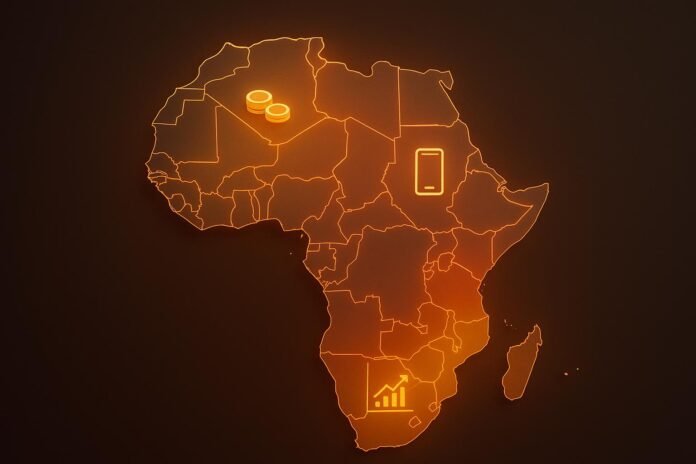Africa’s Fintech Boom: Key Regional Trends Driving Growth
Africa’s fintech industry is experiencing unprecedented growth, with revenues projected to surge from $10 billion in 2023 to an astounding $47 billion by 2028. This rapid expansion is fueled by various regional trends, each contributing uniquely to the continent’s financial landscape. Let’s delve into the key developments across West, East, and Southern Africa.
West Africa: The Digital Payments Leader
Funding Volume
West Africa is at the forefront of Africa’s fintech revolution, with Nigeria leading the charge. In 2024, the region raised $587 million in startup funding, with Nigeria alone accounting for nearly $400 million. This impressive figure solidifies Nigeria’s position as one of Africa’s top three startup markets, alongside Kenya and South Africa.
Key Markets
Nigeria’s large population, increasing smartphone penetration, and a burgeoning middle class create fertile ground for digital financial services. Ghana is emerging as a strong secondary market, with mobile money usage surging by 63% in 2023. Meanwhile, francophone West Africa is gaining traction, with countries like Senegal and Côte d’Ivoire witnessing a significant rise in venture capital funding.
Notable Trends
The focus in West Africa is shifting from rapid growth to sustainable profitability. Companies like Wave in Senegal have captured significant market shares, while traditional banks are launching fintech divisions to tap into the growing digital payments market.
Challenges and Opportunities
Despite its successes, West Africa faces regulatory inconsistencies and cybersecurity concerns. However, the region’s young, tech-savvy population and government-backed digital initiatives present vast opportunities for fintech solutions, particularly for the unbanked.
East Africa: The Mobile Money Powerhouse
Funding Volume
East Africa has emerged as a leader in fintech funding, attracting $725 million in 2024, with Kenya accounting for a staggering $638 million—88% of the region’s total. This marks a significant shift in investor focus, as East Africa outpaces West Africa in funding.
Key Markets
Kenya, often referred to as the "Silicon Savannah," has built a robust digital payments ecosystem, primarily driven by M-Pesa. The platform processes over 61 million transactions daily, serving more than 50 million active users. The digital payments market in Kenya is projected to grow at an annual rate of 14.1% through 2028.
Notable Trends
While mobile money remains dominant, there is a growing interest in card payments and digital banking. However, the drop in equity funding for fintech companies indicates a shift in investor focus toward other sectors.
Challenges and Opportunities
Scaling remains a significant challenge, with only 5% of seed-funded startups reaching Series A funding. Yet, opportunities abound in alternative capital-raising options and open finance initiatives, supported by progressive regulations.
Southern Africa: Navigating Challenges
Funding Volume
In stark contrast to its counterparts, Southern Africa experienced a 36% drop in fintech funding in 2024, with South Africa contributing 99% of the total. This decline highlights the broader funding slowdown across the continent.
Key Markets
South Africa remains the powerhouse of the region, generating around 40% of Africa’s financial services revenue. The market is expected to grow steadily, but challenges like regulatory complexities and low digital literacy persist.
Notable Trends
Innovations like TymeBank, the first digital bank in Africa to achieve profitability, showcase the region’s potential. Companies are diversifying funding strategies, exploring debt financing, and focusing on emerging technologies.
Challenges and Opportunities
Southern Africa faces hurdles such as regulatory complexities and a general reluctance toward entrepreneurial risk. However, the mature financial sector presents opportunities for fintech companies to fill gaps left by traditional banks.
Regional Comparison: Strengths and Weaknesses
West Africa
- Strengths: Vibrant fintech ecosystem; leadership in deal volume.
- Weaknesses: Regulatory inconsistencies; infrastructure gaps.
East Africa
- Strengths: Mobile money dominance; growing investor interest.
- Weaknesses: Limited diversification; scaling challenges.
Southern Africa
- Strengths: Established financial sector; strong regulatory framework.
- Weaknesses: Declining funding; limited growth momentum.
Conclusion
Africa’s fintech landscape is a dynamic and evolving ecosystem, with each region contributing uniquely to the continent’s financial future. The growth potential remains immense, driven by a young, tech-savvy population and increasing investor interest. As the sector continues to mature, addressing infrastructure gaps and regulatory challenges will be crucial for unlocking further opportunities.
For the latest insights and developments in Africa’s fintech scene, platforms like Tech In Africa provide daily updates on the startups and innovations shaping the continent’s digital future.

